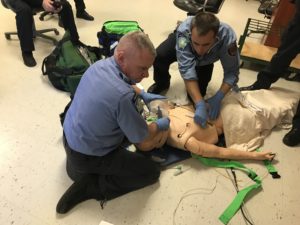Advanced Practices for “Basic” Ventilation: More effective uses for fundamental tools
Squeezing a bag valve mask may be considered a “basic skill”, but there’s nothing “basic” about patient ventilation. How does elevating a patient’s head make a difference? Should you use a nasal canula on the patient under the mask? How long is the delay between desaturation and a drop in SpO2 reading? Which “tips and tricks” actually work in the field? This session looks at the latest prehospital research on oxygenation and ventilation and uses it to expand the emergency care toolbox for all attendees, regardless of certification level.
Teaching Formats:
-Lecture
-Demonstration
-Hands-on
-Question and Answer
Key Concepts:
-Elevate & Oxygenate
-Anatomy
-Physiology
-V/Q
-BVM Manometers for PIP
-Sizing and volume for child and pediatric bags.
-Multi-Masks
-BVM Timers
-PEEP
-CPAP
-BiPAP
-Inspiratory / Expiratory Ratio
-SpO2 2 wave vs 7 wave O2
-etCO2
Learning Objectives: Students will be able to:
- Describe normal ventilation and gas exchange in the lungs and in the tissues.
- Identify the problems that a variety of traumatic injuries and medical conditions present to normal gas exchange physiology.
- Prioritize prehospital airway, breathing, and circulation tools and techniques to improve effective gas exchange based on patient condition and environment as well as their immediate and near-future needs.
- Apply the “elevate and oxygenate” technique for patients under either / both BLS and ALS care.









